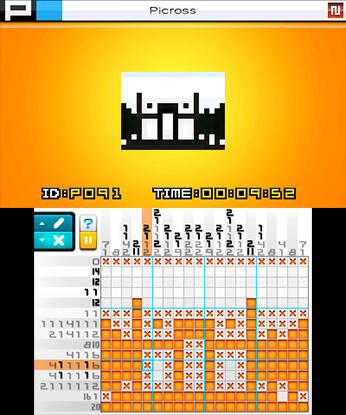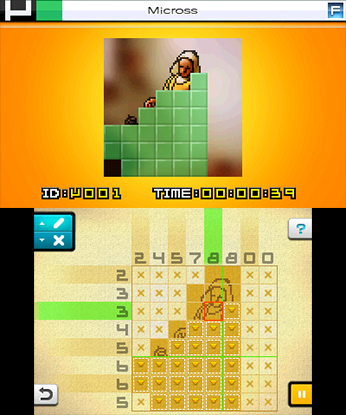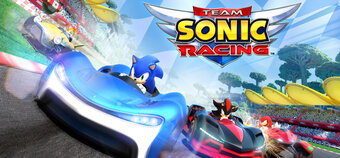Between all the hard-hitting, bigger budget Mario Karts, Pokemans and Zeldas, it's sometimes easy to forget the multitude of smaller games that keep the 3DS ticking over between major releases. And sometimes, all you want is a little puzzle game to fill in a few minutes on the bus - or keep you up until the early hours as you try to figure out which are the last few blocks you need to chisel away. And this is where Picross comes in.
if you haven't played one of the previous games, here's a quick refresher to get you up to speed. Picross is a portmanteau of the words 'picture' and 'crossword', with the long running series essentially revolving around filling in, or chiselling away at blocks on a grid to make a picture. Around the sides of the grid are numbered clues, which tell you how many squares on that particular row or column need to be filled in, with only one piece of small print to keep in mind - two adjacent numbers must be separated by at least one square's space. For example, in a ten by ten grid, a line that has a clue of "3 6" could be solved with a line of three squares followed by a space, followed by another line of six blocks. Using logic like this to fill in all the squares on the board will eventually reveal a picture, although incorrect stabs at the grid will net you a sizeable time penalty. Trust us, it's a lot harder to explain than it is to do!

Who knew filling in blocks could be so addictive?
As you may be able to guess from the title, Picross e4 is the forth iteration in the Picross e series, a downloadable set of Picross games at a bargain-iferous £4.50 each. With more than 150 puzzles across several different game modes, and bonus puzzles for those that have purchased any of the previous games, there's certainly a fair bit to keep you going, with the last three instalments sucking up fifteen to twenty hours apiece, and e4 following in much the same way. In fact, Picross e4 is the same as its predecessors in almost every way.
The main mode of play, cunningly called 'Picross' is a selection of standard puzzles on increasingly large grids, ranging from 5x5 squares to the new 20x15 size. Under standard rules, you simply need to use logic (and sometimes a bit of trial and error) to fill in the blocks of the grid to reveal a pixel picture, following the numbered clues at the sides. As you play, a clock constantly ticks up, and you have a maximum of 60 minutes to solve each puzzle - which may sound like a lot, but when each wrong tap carries with it a fairly hefty time penalty, later puzzles may see you edging dangerously close to the limit if you're not careful.
If you don't enjoy working under such high pressure conditions, you can always try your hand at 'Free Mode' rules, which does away with the time penalties altogether (although you still have a constantly counting up clock to contend with). The catch is that any mistakes you make won't be flagged up, so you run the risk of getting yourself rather mixed up if you're not careful. When solving the standard puzzles in Picross mode, you can toggle between the standard rules and free rules in the options, which is a nice touch.
Where 'Free Mode' really comes into its own though, is in the Micross mode, where you have no option to switch back to classic rules. Originally seen in Picross e2, these puzzles are basically a collection of smaller 'Micro Picross' puzzles (hence the name), which add up together to reveal a famous painting once solved. The only downside to these are there's only two pictures to work through - e2 had five Micross puzzles as well as a healthy 60 Free Mode puzzles to plod through on top of the regular mode, making Picross e4 seem a touch light on 'normal' puzzles by comparison.

We wish there were more of these...
What it lacks in Micross puzzles, however, Picross e4 more than makes up for with a massive dollop of 'Mega Picross' puzzles, a concept that first popped up in the previous game and requires a bit of a reworking of your logic. In your average Picross puzzle, the numbered clues only apply to a single column or row of blocks - but in Mega Picross, some of the number cues apply to two adjacent columns instead. For example, a fat, two-column-spanning '2' means that you have a horizontal line of two squares filled in instead of your standard vertical duo. Requiring a rather different approach, and not all that well explained in the tutorial, we weren't a big fan of them in e3 - and e4 has even more of the things. And just to really rub it in, the unlockable bonus 'thanks-for-buying-all-our-previous-games' puzzles are all Mega Picross puzzles too...
With the addition of the new 20x15 puzzles, we thought Jupiter may have taken the opportunity to add in a much-needed zoom function, as despite the fact we usually play on a 3DS XL, even it's larger screen can sometimes not seem quite big enough. Sadly, there's no such luck, which means you can still sometimes find yourself clipping nearby spaces and accidentally getting a penalty, simply because you're working with such tiny squares on the screen. Bumpy bus rides and Picross e don't tend to mix, either.
However, for the most part, these are only fairly minor issues. Our only main gripe with Picross e4 - and this applies to it's predecessor Picross e3 too - is the new Mega Picross puzzles. It's a concept we find very hard to wrap our brain around, and when it comes at the expense of the 'proper' picross puzzles, e4 ends up feeling somewhat smaller than its predecessors. As a £4.50 download from the eShop, there's still a decent-sized chunk of puzzling fun to be had here though, and Picross e4 would be a welcome addition to any Picross-fanatic's 3DS library.
Format Reviewed: Nintendo 3DS





















